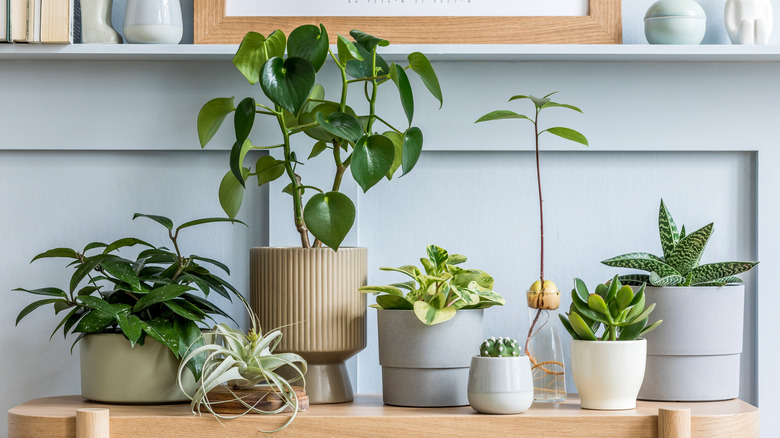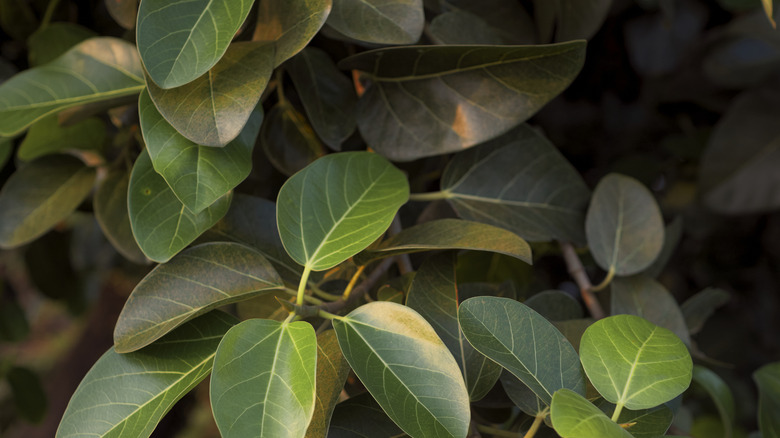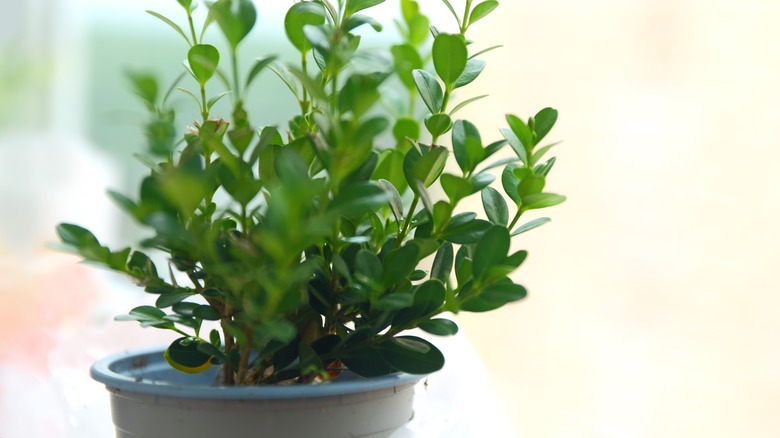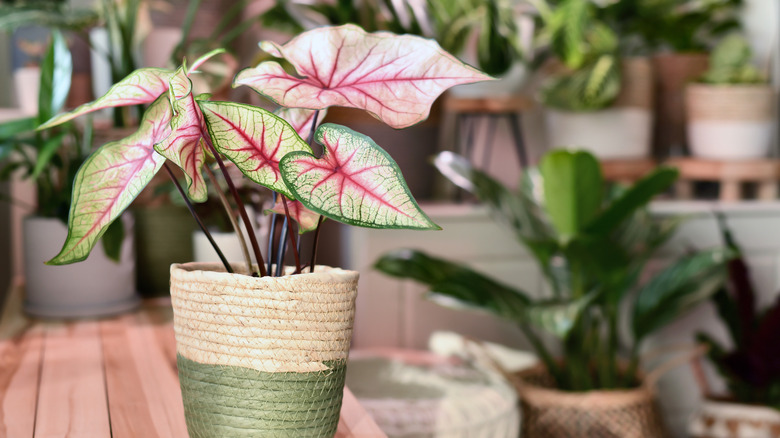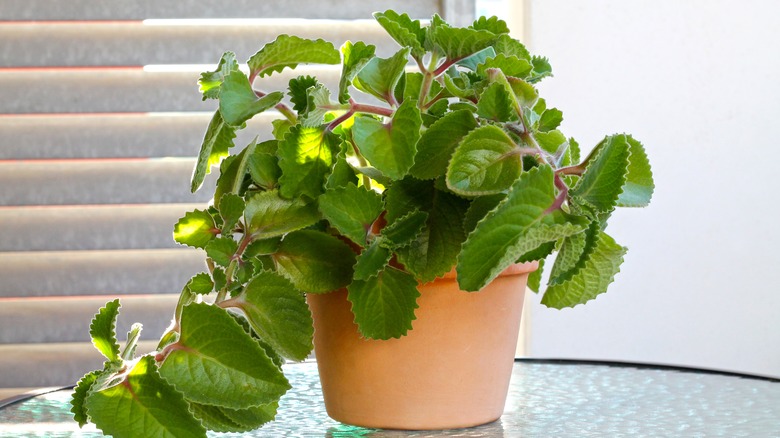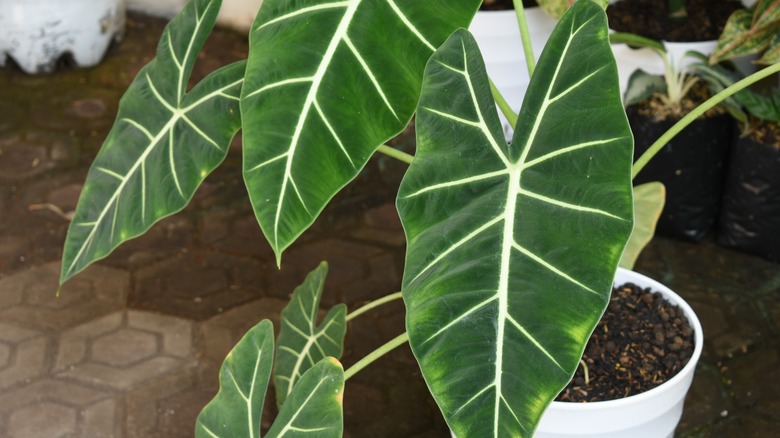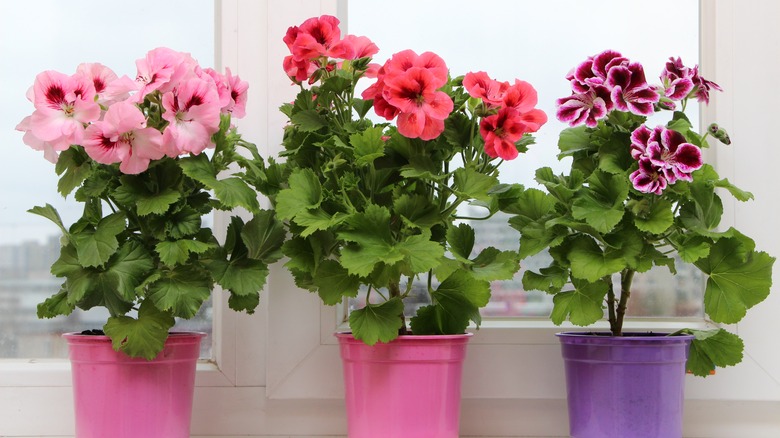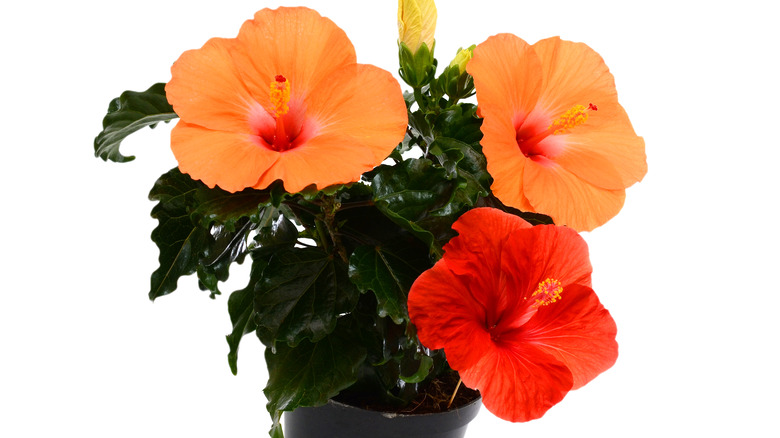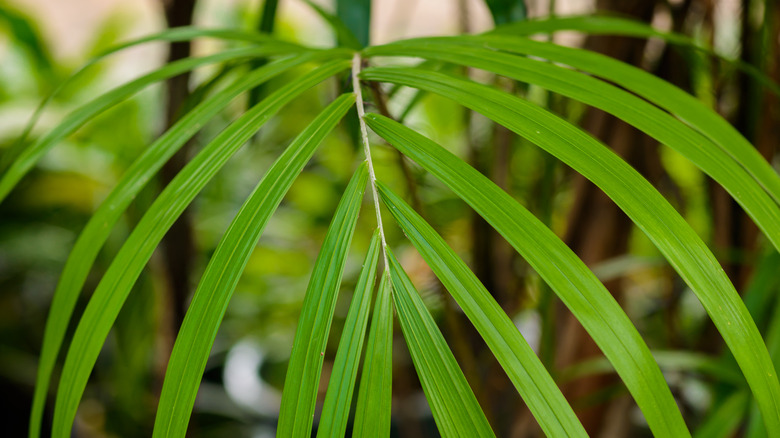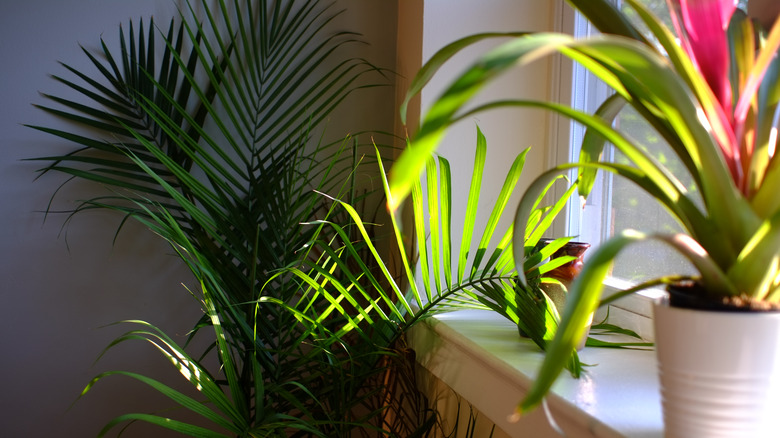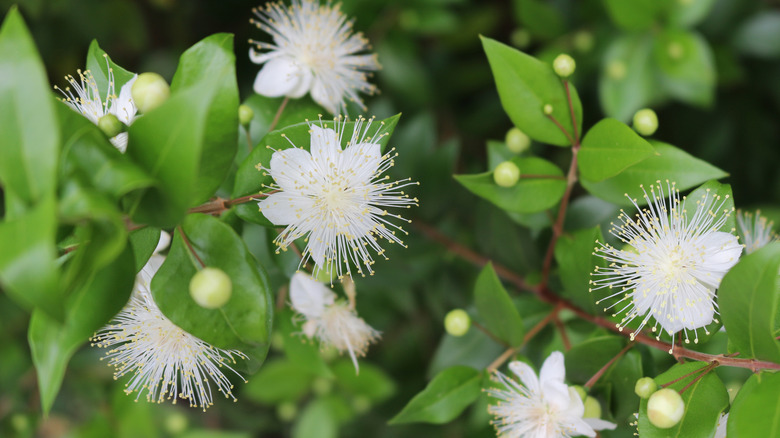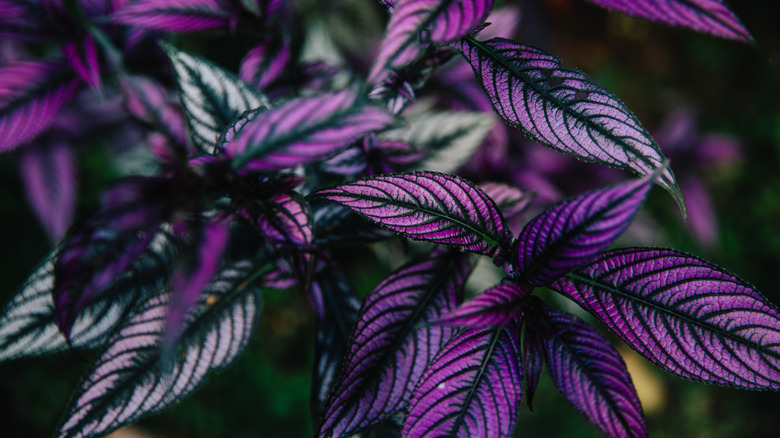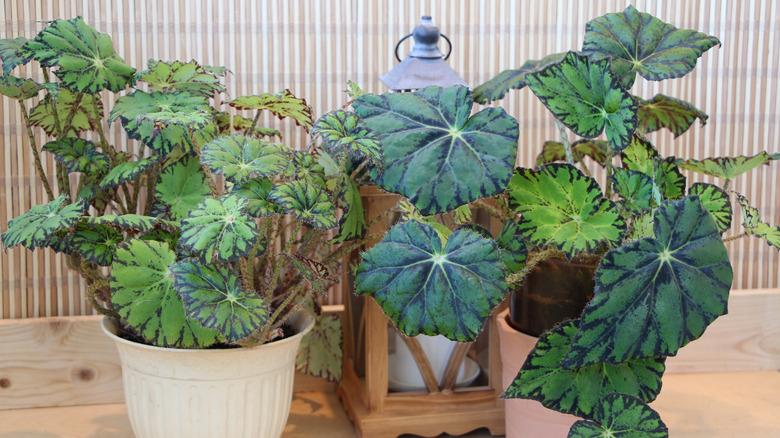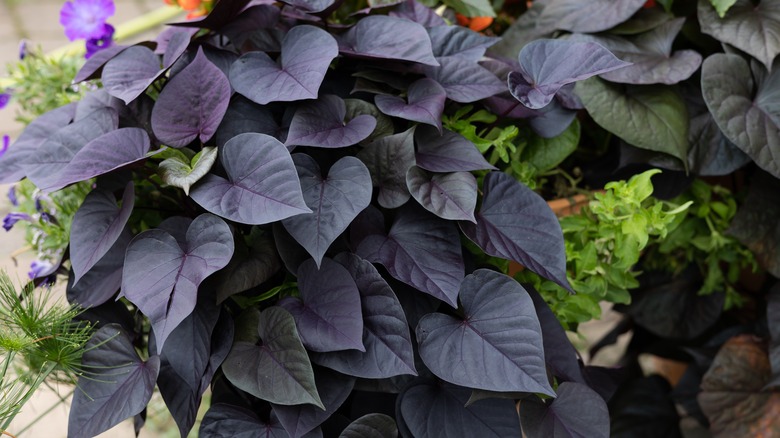Outdoor Plants That Also Thrive Indoors
The cooler months are officially here and for those plant lovers, that means turning their focus inside. But the good news is you don't have to sacrifice certain outdoor plants for indoor ones. You can continue to care for outdoor plants inside, though it will take a little extra attention, patience, and fortitude. While you may have specific indoor plants that you already care for, that doesn't mean you can't bring popular outdoor ones in. In fact, according to Ambius, bringing outdoor plants inside is a great way to improve your home's air quality.
But they do so much more than that. Plants also help reduce stress and noise levels and encourage you to venture into nature every now and then. If you decide to care for outdoor plants inside, the most important thing to remember is their specific care instructions. Every plant requires different levels of water, sunlight, and soil. Luckily, there are a ton of outdoor plants that thrive inside and we're going to share our favorites with you.
Add texture to rooms with a Bengal fig
When designing the interior of your home, you may hear the word "texture" used, especially by professionals. Texture, as defined by Luxdeco, is adding items with a specific feeling or visual appearance to give the room a specific texture or vibe. A lot of wool, for example, will make a room feel comfy, whereas a lot of wood will make a room feel outdoorsy. Texture can be added with simple elements like a blanket, piece of artwork, or furniture. But there are plants that provide beautiful texture to a room and one of them is the Bengal Fig.
Also known as a Fiscus Audrey, the Bengal Fig is popular for its oblong leaves that stand out in texture alone. For newer indoor plant owners, this plant is a great one to start with as it's less fussy than others. Their tropical roots mean they prefer indirect, bright sunlight and they can be placed in just about any room. The one thing you want to avoid is keeping them near vents or areas that get drafty. The last thing you want to do is make them too cold and then they won't grow properly, if at all.
Test your skills with boxwood
While the Bengal fig is a good indoor starter plant, boxwoods are ideal for experienced plant owners who want to stretch their limits. Although boxwoods are recommended for outdoor use only, they are capable of surviving indoors with the right amount of sunlight and care. They grow slowly by nature and so you can test your skills by seeing how you do with them indoors.
According to Hunker, you'll want to keep the pot in a spot where there's full or partial sunlight. Your boxwood only needs to be watered once a week and you want to give it at least one inch of water every time. Check for yellow leaves as this means it requires a high-nitrogen fertilizer. Make sure to prune the boxwood every spring and once the outer limbs reach the rim of the pot, repot it in a larger one.
Let caladium leaves inspire you
If Bengal fig leaves provide texture to a room but you prefer color and vibrancy to inspire you, then you'll love a caladium. The heart-shaped leaves of this plant grow in a variety of whites, pinks, reds, and greens. It's a beautiful plant to look at and gain a ton of inspiration from. And when it's taken care of properly, you'll never run out of vibrancy in the room. Mod + Mint recommends a lot of water, indirect sunlight, and humidity if you want to keep a caladium alive inside.
When it comes to sunlight, an indoor caladium only requires two to four hours of it, so do your best to keep it near an east-facing window as morning light works best. Another good practice is to rotate the pot so every side gets ample sun. Because of its South American roots, you want to keep your caladium moist by misting the leaves and keeping the soil damp. A nifty trick is setting it up in your bathroom where it'll get plenty of humidity plus sunlight if the window is big enough.
Care for a coleus indoors
One of the trickiest things about growing outdoor plants inside is figuring out how much sunlight to expose them to. Because many outdoor plants gain sunlight through the shades of trees, it can be a task in and of itself to figure out how to best place them inside. This is especially true for a coleus plant. Even though this is a plant that is typically grown outdoors, the Missouri Botanical Garden notes that it can provide indoor color all winter long.
That's good news for indoor plant enthusiasts who want to enjoy coleus's vibrant leaves and minimal appearance. What you want to focus on is placement. While coleus loves sunlight, you want to avoid intense light all day. You want to ensure the soil is not too soggy, but not super dry so watering regularly is a must. During the spring and summer, focus on adding water-soluble fertilizer once a week for strength. Finally, remove blooms as they appear, otherwise, they'll draw too much energy and kill the plant.
Get dramatic with elephant ears
Elephant ears derive their name from the fact that their leaves look like elephant ears. Because of this, many people use these plants to add a statement in certain rooms. While outdoor elephant ears can grow quite large, indoor versions will stay manageable as long as you care for them properly. Elephant ears act as natural air purifiers and their distinct look will make a great conversation starter.
For the best care, Gardening Etc recommends bright, indirect sunlight, but not too much since the sun can cause discoloration to the leaves. You also want to ensure you're keeping them clean by removing any dust that builds up on the leaves. Because of their tropical roots, elephant ears thrive best with a bit of humidity, so make sure to mist the leaves regularly and water them once a week. You can also group a bunch of them together to trap humidity or keep your temperature set at no more than 72 degrees Fahrenheit to prevent the air from becoming too dry.
Protect geranium from winter frost
A thriving outdoor plant that can be cared for inside with proper maintenance is geranium. This native South African plant needs a certain amount of sunlight each day and outside they get their fill. If you bring them inside, you'll need to be diligent in their placement. But the first thing you want to do, according to The Star Phoenix, is to bring them inside before the first frost. If you wait too long after that, they won't survive.
Once inside, you can opt to replant them in smaller pots or leave them in what they're currently in. Settle them in a warm spot that gets at least four hours of indirect sunlight. You can also use a heating pad underneath the pot to help with growth. Every three to four weeks, add a water-soluble fertilizer and water them moderately. Your main focus with Geranium is to keep them relatively moist as this will prolong their lifespan and give the room you have it in a constant calming vibe.
Feel tropical with hibiscus
If you want an indoor plant that makes you feel like you're sipping cocktails in a tropical destination, then hibiscus is your go-to. This native tropical plant is vibrant and stunning when cared for properly and though it requires a bit of extra attention, it'll be worth the neediness. One of the first things you should do when growing hibiscus indoors is to avoid using clay pots, which can upset the soil's pH balance. Also, opt for a container that is quite snug. As Mother Nature reports, hibiscus thrives in close-knit planting pots.
When it comes to placement in your home, choose a windowsill that gets lots of sunlight. Hibiscus requires at least eight or more hours of direct sunlight a day so make sure to keep them in a spot that gives you that. If not, you'll need to move it around. You'll want to use a slow-release fertilizer and add it once a week. On top of that, hibiscus should be watered daily with warm water. However, if you start to notice yellow leaves, cut back on your watering. Despite its need for extra attention, this plant will brighten up any room and have you dreaming of tropical sunsets all winter.
Stand tall with a lady palm
If you're low on space, then a lady palm is a great addition because it grows vertically rather than branches out. This makes it perfect for tight corners, though it's important to keep it in a spot where it'll get bright, indirect sunlight. Many people will display this plant in bathrooms or in well-lit entryways. According to Guide to Houseplants, a lady palm is one of the easiest plants to grow indoors, mainly because of the direction it grows in, but also because of the speed at which it grows.
Lady palm is a slow grower, which means you have time to learn all the tricks to keep it alive. Essentially, it's a great plant to learn plant care with. In terms of care, you want to focus on keeping the soil moist and removing dust from leaves so they can do their job, providing energy to the plant via photosynthesis. Lady palms improve the air quality of your home and their fan pattern makes them stunning to look at. When the plant outgrows its current container, repot it in another one and make sure to snip off any brown leaves or tips to prevent them from spreading.
Make a statement with a majesty palm
Another slow-growing plant that is easy to care for is a majesty palm. It's also one of the most common houseplants, so it'll do well inside as long as you have the right environment. The main thing you want to focus on is giving it plenty of sunlight. Majesty palms do best with six to eight hours of direct sunlight, so placing it near a sunny window is best. If you have room in a foyer or entryway, it can make a great statement piece there.
According to Costa Farms, it's key to keep the soil of majesty palms moist. Letting the soil dry out completely will cause the plant to die. Its tropical roots also mean it craves humidity, so keeping it in a room with a humidifier is one way to ensure it's taken care of. Though it grows slowly, you will want to repot it once it outgrows its current pot. Finally, add a general fertilizer every two to three months to encourage growth and strength.
Smell the sweet scent of myrtle
Myrtle is a member of the bonsai family line of trees and is a perfect miniature tree to add to your home during the winter. Its star-like flowers produce a delicious scent that is often used in perfumes, soaps, essential oils, and more. This makes it an ideal plant to include in your home as the aromatherapy will linger in whatever room you set it in. According to Bonsai Boy, one of the best places to put a myrtle during the winter is on a windowsill facing south. This will ensure it gets four to six hours of direct sunlight.
When it comes to caring for this miniature tree, you want to make sure the soil never dries out completely. Outside of watering it moderately, misting the leaves and flowers will help it maintain moisture. Another way is to set the plant in a shallow tray with equal parts water and pebbles or stones. This will help the plant stay healthy, especially in the winter months when the air is dry due to cold weather and indoor heating. Finally, a general-purpose liquid fertilizer is best and should be added once a month.
Feel the vibrancy with a Persian shield
Although a Persian shield prefers shady and damp conditions, it is pretty easy to maintain indoors. In fact, the plant's deep purple leaves will make a powerful statement in any room and give your home a comforting boost. However, the purple shade will fade if you expose them to too much direct sunlight. That's why you want to keep your Persian shield in a spot that gets part sun and part shade. This will ensure healthy growth and vibrant leaves.
Masterclass recommends keeping your Persian shield moist, especially since they're warm-weather plants native to Myanmar. This means misting the leaves every other day and using a slow-release fertilizer to support strength. This is another plant that will benefit from a room with a humidifier if you have the space. You might think its roots will mean it loves sunlight, but Persian shields thrive better in shady, damp conditions. You also want to remove any dead branches to keep the plant looking its best and to avoid any possible spread of pests and diseases.
Brighten up a room with a rex begonia
If you want to liven up a room that is minimally designed, a great plant to do that would be a rex begonia. This particular plant has leaves that are so robust in color and they have so many varieties, you won't know which one you'll get until it's grown. The plant has been recorded to grow in greens, whites, reds, pinks, silvers, and more. According to Smart Garden Guide, the rex begonia's unique leaves may have forms of veining, puckering, spotting, splotching, ruffling, and more. This makes them highly sought-after plants to brighten up a room.
When taking care of these plants indoors, it's best to go with a pot or hanging basket so long as there is ample room around it for the leaves to grow. You want to avoid overcrowding rex begonia since they tend to grow outward. It's also a good idea to put them in a pot that is one to two sizes larger to give them plenty of room to expand. Like most plants on this list, never let the soil dry completely, and rotate the plant so all sides get equal amounts of sunlight a day.
Add color with a sweet potato vine
Another plant that comes with a variety of options is the sweet potato vine. While sweet potato vine truly thrives outdoors, it can be properly cared for inside as well. And because you have several varieties available to you, you can bring differently shaped leaves and colors into the mix. This plant requires a lot of room to grow and should be pruned regularly. This allows you to keep it from overtaking the spot you set it in and it removes any damaged foliage.
Epic Gardening suggests keeping your sweet potato vine in a sunny spot, particularly near a south-facing window. This plant needs a solid six hours of direct sunlight so the sunnier, the better. It should be watered weekly to keep the soil from drying out and as for fertilizer, this plant works best with high-nitrogen soil that encourages strong roots and leaves. One thing to note about sweet potato vines, however, is that they are not pet-friendly. So if you have pets, you may want to find a different plant to care for as the leaves are toxic for animals.
